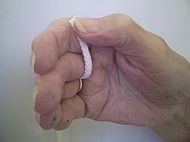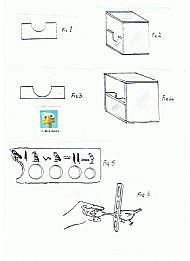A QUICK FIX GADGET
FOR A BITING BIRD
If in spite of all your best efforts & patience, he still bites. Then this little gadget used by many professional trainers as a quick fix for a biting bird brought in by a desperate owner, should help. The requirements for this fix are just one little inexpensive item. Its effective use depends on timing & accuracy. It needs practice on a human helper before putting it to use on a live bird. You will need 1 or 2 mtrs of thin plastic tube. The type used to circulate air in fish tanks is just right for an effective blower tube. To operate it just put one end in your mouth & give a quick blow. The cure for biting is brought about by the unexpected puff of air inside the beak just as the bird is about to bite you. Pass the tube down the right sleeve if your right handed. The end of the tube should then run down the back of your right hand & out between your second & third finger & the end should be held hidden between your thumb & index finger.(See Photo) The other end ready in your mouth. Offer a tiny piece of cake or other treat through the bars, to help establish the friendly atmosphere between you & the bird. Put your right hand in the cage with a treat along side the blower & the other end in your mouth. Invite him to step-up. If he attempts to bite your finger. Wait until his beak is open & close to your finger, then give him a very short quick puff right inside his beak. NOT his face or eyes. I hear some bird keepers are suggesting, don't use a tube & just blow into his face. Serious eye problems can be caused by blowing into a birds face. Plus he'll know who's causing his discomfort. Which wont help with the bonding process. An intelligent bird learns to close his eyes & carry on biting. Again ask him to step-up as if nothing happened. If he refuses to step-up but doesn't attempt to bite, remove your hand & try again later. If he step-up without biting it doesn't mean he's cured. There's always tomorrow. Always offer a treat for each step-up. Every attempt at biting gets a blow & delays play out time. It
shouldn't take him long to figure it out. Do not poke your bird to encourage step-up. Do not dispense with the tube untill at least a week of no biting......OK...B.J.
As a child, I remember my father using the air blower to good effect on a troublesome ostritch.
To emphasis the point about accuracy & timing. I had a friend who was so good with this little gadget, that his customers were convinced, after closely watching him cure a biting bird in a matter of minutes. That he had some mysterious magic power over birds, which he naturally encouraged & charged a higher fee for.


